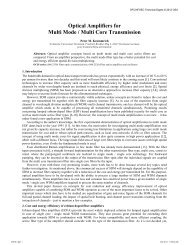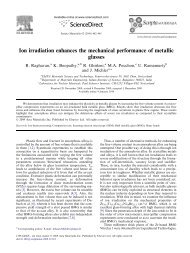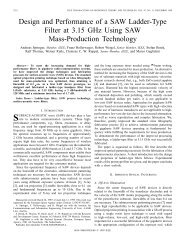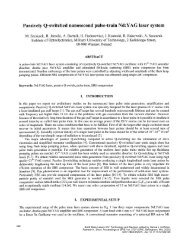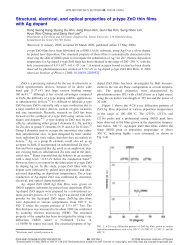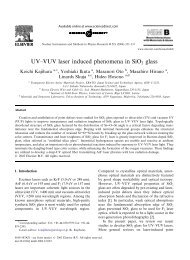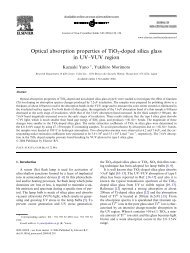Variant selection of primary, secondary and tertiary twins in a ...
Variant selection of primary, secondary and tertiary twins in a ...
Variant selection of primary, secondary and tertiary twins in a ...
You also want an ePaper? Increase the reach of your titles
YUMPU automatically turns print PDFs into web optimized ePapers that Google loves.
2052 S. Mu et al. / Acta Materialia 60 (2012) 2043–2053<br />
<strong>of</strong> the matrix, which has been virtually completely replaced<br />
by the tw<strong>in</strong>. Two other first-order <strong>tw<strong>in</strong>s</strong>, gra<strong>in</strong>s c <strong>and</strong> d, were<br />
also formed, but occupy much smaller volumes than the<br />
dom<strong>in</strong>ant first-order tw<strong>in</strong> b. These first-order <strong>tw<strong>in</strong>s</strong> conta<strong>in</strong><br />
several second-order <strong>tw<strong>in</strong>s</strong>, such as gra<strong>in</strong>s e <strong>and</strong> g. Gra<strong>in</strong>s f<br />
<strong>and</strong> h are third-order <strong>tw<strong>in</strong>s</strong> that have essentially consumed<br />
their second-order tw<strong>in</strong> parents e <strong>and</strong> g, respectively.<br />
To <strong>in</strong>vestigate the <strong>selection</strong> <strong>of</strong> the first-order tw<strong>in</strong> variants,<br />
we performed full constra<strong>in</strong>t Taylor simulations on<br />
all 11 neighbor gra<strong>in</strong>s <strong>of</strong> gra<strong>in</strong> b. For this purpose, the<br />
shape change attributable to the first-order tw<strong>in</strong>n<strong>in</strong>g was<br />
imposed on each nearest neighbor gra<strong>in</strong> separately <strong>and</strong><br />
the slip (c) distributions on the activated systems were<br />
determ<strong>in</strong>ed. In this way, it was possible to establish which<br />
variant required the least expenditure <strong>of</strong> energy (Taylor<br />
energy) P n<br />
s¼1 s sc s , where n is the number <strong>of</strong> activated slip<br />
<strong>and</strong> tw<strong>in</strong>n<strong>in</strong>g systems <strong>and</strong> s the critical resolved shear stress<br />
<strong>of</strong> the respective system. This simulation was carried out<br />
for each <strong>of</strong> the six first-order tw<strong>in</strong> variants. For calculation<br />
<strong>of</strong> the Taylor energy, we assumed ratios <strong>of</strong> the critical<br />
resolved shear stresses s for basal, prismatic <strong>and</strong> pyramidal<br />
slip, as well as extension tw<strong>in</strong>n<strong>in</strong>g <strong>of</strong> 1:9:10:4 with respect<br />
to basal slip. This has been shown to yield good results<br />
<strong>in</strong> Mg deformation texture simulations [14].<br />
The results are presented <strong>in</strong> Fig. 8a <strong>in</strong> terms <strong>of</strong> the Taylor<br />
energies required for the formation <strong>of</strong> the three variants <strong>in</strong><br />
each neighbor<strong>in</strong>g gra<strong>in</strong>. The total Taylor energies summed<br />
over all 11 neighbor<strong>in</strong>g gra<strong>in</strong>s are illustrated <strong>in</strong> Fig. 8b.<br />
(The other three variants, which did not form <strong>in</strong> the microstructure,<br />
require higher total work than the observed three<br />
variants. Therefore, their Taylor energies are not presented<br />
<strong>in</strong> the figures.) Although variant c requires the lowest<br />
energy, it also has the lowest SF (0.323). Conversely, variant<br />
d, with a higher SF (0.392), is barely detectable <strong>in</strong> the microstructure,<br />
apparently because <strong>of</strong> its high Taylor energy.<br />
Such a first-order tw<strong>in</strong> simulation is only an approximation,<br />
<strong>of</strong> course, s<strong>in</strong>ce the adjacent gra<strong>in</strong>s do not <strong>in</strong> fact<br />
deform homogeneously. Furthermore, many nearest neighbor<br />
gra<strong>in</strong>s are also affected by gra<strong>in</strong> <strong>in</strong>teractions with their<br />
adjacent gra<strong>in</strong>s. The third-order <strong>tw<strong>in</strong>s</strong>, on the other h<strong>and</strong>,<br />
are only surrounded by a s<strong>in</strong>gle first-order tw<strong>in</strong>, i.e. firstorder<br />
tw<strong>in</strong> b, see Fig. 3. The Taylor analysis <strong>in</strong> this case,<br />
with only one neighbor gra<strong>in</strong>, i.e. gra<strong>in</strong> b, yields the results<br />
for <strong>tw<strong>in</strong>s</strong> f <strong>and</strong> h, illustrated <strong>in</strong> Fig. 9. Here it can be seen<br />
that variant et5 (i.e. f) <strong>of</strong> second-order tw<strong>in</strong> e <strong>and</strong> variant<br />
gt6 (i.e. h) <strong>of</strong> second-order tw<strong>in</strong> g are energetically preferred,<br />
<strong>in</strong> excellent agreement with the observations.<br />
From this analysis, we conclude that the accommodation<br />
stra<strong>in</strong> hypothesis is <strong>in</strong>deed consistent with an energym<strong>in</strong>imization<br />
pr<strong>in</strong>ciple, as evident from the Taylor simulations<br />
for simple geometries. For more complex arrangements, the<br />
accommodation stra<strong>in</strong> hypothesis (Sections 4.2–4.4) leads<br />
to better predictions than the full constra<strong>in</strong>t Taylor model<br />
<strong>of</strong> Section 4.5, which does not take the full effects <strong>of</strong> gra<strong>in</strong><br />
<strong>in</strong>teraction <strong>in</strong>to account.<br />
Fig. 8. (a) Simulated Taylor energies expended <strong>in</strong> the 11 nearest-neighbor<br />
gra<strong>in</strong>s dur<strong>in</strong>g the formation <strong>of</strong> the observed three <strong>primary</strong> extension <strong>tw<strong>in</strong>s</strong>.<br />
(b) Simulated total Taylor energies associated with the formation <strong>of</strong> the<br />
three variants normalized to take <strong>in</strong>to account the lengths <strong>of</strong> the respective<br />
gra<strong>in</strong> <strong>in</strong>terfaces.<br />
Fig. 9. Normalized Taylor energies expended <strong>in</strong> neighbor<strong>in</strong>g gra<strong>in</strong> b<br />
dur<strong>in</strong>g the formation <strong>of</strong> <strong>tertiary</strong> extension <strong>tw<strong>in</strong>s</strong> (a) e ! f <strong>and</strong> (b) g ! h.<br />
The variants with the lowest Taylor energies were the ones observed <strong>in</strong> the<br />
experiments.




